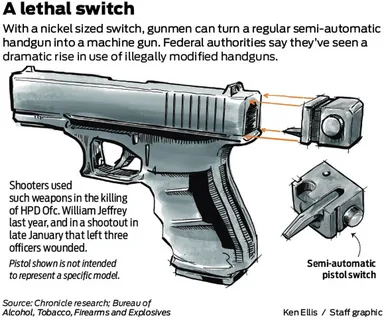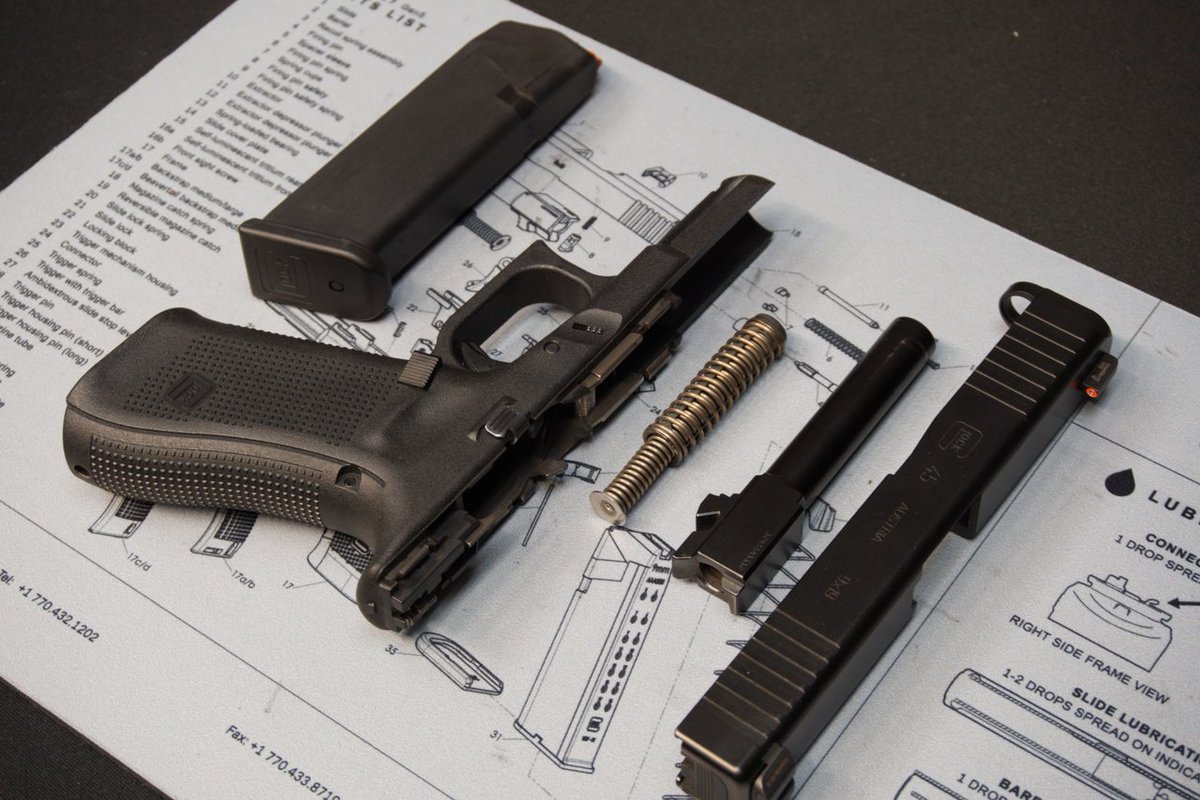The Glock pistol is renowned worldwide for its reliability, simplicity, and wide adoption by civilians, law enforcement, and military alike. Despite
The Glock pistol is renowned worldwide for its reliability, simplicity, and wide adoption by civilians, law enforcement, and military alike. Despite being designed as a semi-automatic handgun, a small mechanical device known as the Glock switch has emerged, enabling the conversion of these pistols into fully automatic firearms. This article offers an in-depth look at the Glock switch — how it works, its legal implications, law enforcement challenges, and its broader impact on gun control and public safety.
must visit: tradeinfinite

What Is a Glock Switch?
A Glock switch is a small mechanical device that modifies a Glock pistol’s firing mechanism, converting it from a semi-automatic to a fully automatic weapon. The device usually resembles a small lever or button that attaches to the rear of the pistol’s slide, altering how the firearm cycles rounds.
When engaged, the Glock switch allows the firearm to fire continuously while the trigger is held down, vastly increasing its rate of fire compared to the standard semi-automatic mode, which requires a separate trigger pull for each shot.
How Does the Glock Switch Work?
To appreciate the effect of the Glock switch, it helps to understand the firing mechanics of a Glock pistol:
- Standard Operation: The Glock operates semi-automatically, firing one round per trigger pull. The trigger bar releases the firing pin to strike the primer, the bullet fires, and the slide cycles to eject the spent casing and chamber a new round. The trigger must then be released and pulled again to fire the next shot.
- With Glock Switch: The switch interferes with the trigger bar’s reset mechanism, preventing it from re-engaging after a shot. As a result, the firing pin remains engaged as long as the trigger is held down, allowing multiple rounds to be fired automatically.
The conversion does not require permanent modifications to the firearm’s internals, making the Glock switch a quick, reversible, but illegal conversion device.
Historical Context and Rise
Introduced in the early 1980s, the Glock pistol revolutionized handgun design with its polymer frame and simple construction. It became widely adopted by law enforcement and civilian shooters globally. The Glock switch, however, is a relatively recent phenomenon, gaining traction with advances in machining, 3D printing, and underground online marketplaces.
The device’s compact size and easy installation have made it popular among some firearm enthusiasts, but more troublingly, it has also found its way into criminal hands, raising concerns over its misuse and legality.
Legal Status of the Glock Switch
Under U.S. federal law, the Glock switch is classified as a machine gun. This classification falls under the National Firearms Act (NFA) of 1934 and the Gun Control Act (GCA) of 1968, which regulate automatic firearms and their components.
- Machine Gun Definition: A machine gun is any weapon that fires more than one round per trigger pull, or any device that converts a weapon into such.
- Possession and Manufacture: Possessing, manufacturing, or distributing a Glock switch without registration and licensing from the Bureau of Alcohol, Tobacco, Firearms and Explosives (ATF) is a felony.
- Penalties: Convictions can result in up to 10 years in federal prison, hefty fines, and permanent revocation of firearm rights.
- State Laws: Many states impose stricter laws, often banning possession outright.
This legal framework reflects the high risk associated with such devices, intended to prevent their widespread availability.
Why Is the Glock Switch Controversial?
Several factors make the Glock switch particularly controversial:
- Ease of Conversion: Unlike traditional automatic weapons that require complex manufacturing, the Glock switch offers a simple, reversible way to convert a semi-auto pistol.
- Increased Firepower: The ability to fire dozens of rounds in seconds greatly increases lethality, especially in civilian environments.
- Illegal Distribution: Many Glock switches are manufactured and sold illegally, often bypassing all regulatory oversight.
- Law Enforcement Threat: Officers face increased risks during encounters involving fully automatic handguns.
These factors fuel ongoing debates about firearm regulations, enforcement, and public safety.
Practical Limitations of the Glock Switch
While the device increases firing rate, it does have limitations:
- Accuracy: Fully automatic fire from a handgun is difficult to control due to recoil, reducing accuracy.
- Mechanical Wear: The pistol’s components wear out faster under automatic fire.
- Heat Buildup: Rapid fire generates heat that can cause malfunctions or damage.
- Ammunition Use: The rapid consumption of ammunition limits sustained use.
Despite these drawbacks, the Glock switch remains dangerous in close quarters or mass shooting scenarios.
Law Enforcement and Glock Switches
The rise of Glock switches has prompted law enforcement to adapt:
- Training: Officers receive training to identify modified firearms and safely handle fully automatic weapons.
- Intelligence Gathering: Agencies monitor online sales and track distribution networks.
- Seizure Operations: Increased efforts to confiscate Glock switches and prosecute offenders.
The device complicates policing efforts, elevating the threat level officers face.
Public Safety and Community Impact
Glock switches have contributed to increased gun violence in some areas, particularly where criminal networks use them to enhance firepower. Their presence intensifies the destructive potential of shootings, elevating fear and trauma in affected communities.
Identifying a Glock Switch
The device is small but often visible on the rear of the slide. Signs of a Glock switch include:
- A lever or button attached to the back of the slide.
- Rapid firing behavior inconsistent with normal semi-automatic operation.
- Modified or altered slide components.
If you suspect a Glock switch on a firearm, avoid handling it and report it to authorities immediately.
Legal Alternatives to Glock Switches
For those interested in automatic firearms, legal options exist but are tightly regulated:
- Registered Machine Guns: Owners may legally possess automatic weapons made before 1986 with ATF registration.
- Licensed Dealers: Federal Firearms License holders may sell automatic weapons under strict guidelines.
- Government and Military Use: Fully automatic firearms are used under regulated conditions.
These alternatives ensure automatic firearms are controlled and tracked by authorities.
Conclusion
The Glock switch is a small but significant device with the potential to convert an everyday semi-automatic handgun into a highly lethal fully automatic weapon. Despite its mechanical simplicity, it is classified as a machine gun under federal law and illegal to possess without authorization.
Law enforcement agencies face challenges in detection and enforcement, while the device poses serious public safety risks. Understanding the mechanics, legal framework, and risks associated with Glock switches is essential for policymakers, gun owners, and communities seeking to reduce firearm violence.
Frequently Asked Questions (FAQs)
1. What is a Glock switch?
A small mechanical device that converts a semi-automatic Glock pistol into a fully automatic firearm.
2. Is owning a Glock switch legal?
No, possession without federal registration and licensing is illegal and subject to felony charges.
3. How does a Glock switch alter a pistol’s function?
It bypasses the trigger reset, enabling continuous fire with a single trigger pull.
4. Why are Glock switches dangerous?
They allow rapid firing of many rounds, increasing potential casualties.
5. How do law enforcement officers detect Glock switches?
Through firearm inspections, training, and intelligence operations.
6. Can anyone install a Glock switch?
Yes, installation is simple and requires minimal tools or expertise.
7. What penalties exist for Glock switch possession?
Felony charges, up to 10 years imprisonment, fines, and loss of firearm rights.
8. Are there legal ways to own fully automatic weapons?
Yes, but only with proper ATF registration and compliance with NFA regulations.
9. What should I do if I find a Glock switch?
Do not handle the firearm and immediately contact law enforcement.
10. Does using a Glock switch affect shooting accuracy?
Yes, fully automatic fire is harder to control and less accurate.




COMMENTS